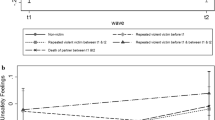Abstract
This paper explores the importance of linking the micro- and macro-level dimensions of household and personal victimization. Specifically, we use the British Crime Survey, a nationally representative sample of 10,905 residents of England and Wales, to examine differences in victimization risk associated with demographic characteristics, lifestyle-routine activities, and community context. In general, victimization risk is highest for the young, the singles, and those who frequently go out at night or leave their homes empty. Independent of these individual-level effects, however, burglary victimization is directly related to community levels of primary (single)-individual households, family disruption, unemployment, and housing density, while personal theft is inversely related to community social cohesion (friendship networks, residential stability). Furthermore, personal theft is positively related to community “street activity” (i.e., rate at which residents go out at night on foot), regardless of individual-level lifestyle. The results thus support a multilevel opportunity model of predatory victimization.
Similar content being viewed by others
References
Aldrich, J., and Nelson, F. (1984).Linear Probability, Logit, and Probit Models, Sage, Beverly Hills, Calif.
Bursik, R., and Webb, J. (1982). Community change and patterns of delinquency.Am. J. Sociol. 88: 24–42.
Cantor, D., and Land, K. (1985). Unemployment and crime rates in the post-World War II United States.Am. Sociol. Rev. 50: 397–332.
Clarke, R., Eckblom, P., Hough, M., and Mayhew, P. (1985). Elderly victims of crime and exposure to risk.Howard J. 24: 74–83.
Cohen, L., and Cantor, D. (1981). Residential burglary in the United States: Lifestyle and demographic factors associated with the probabilty of victimization.J. Res. Crime Delinq. 18: 113–127.
Cohen, L., and Felson, M. (1979). Social change and crime rate trends: A routine activities approach.Am. Sociol. Rev. 44: 588–607.
Cohen, L., and Felson, M. (1981). Modeling crime trends: A criminal opportunity perspective.J. Res. Crime Delinq. 18: 138–164.
Cohen, L., Kluegel, K., and Land, K. (1981). Social inequality and predatory victimization: An exposition and test of a formal theory.Am. Sociol. Rev. 46: 505–524.
Corrado, R., Roesch, W., Glackman, J., Evans, J., and Leger, G. (1980). Lifestyles and personal victimization: A test of the model with Canadian data.J. Crime Just. 3: 129–139.
Crutchfield, R., Geerken, M., and Gove, W. (1982). Crime rates and social integration: The impact of metropolitan mobility.Criminology 20: 467–478.
Decker, D., Shichor, D., and O'Brien, R. (1982).Urban Structure and Victimization, Heath, Lexington, Mass.
Felson, M. (1986). Linking criminal choices, routine activities, informal social control, and criminal outcomes. In Cornish, D., and Clarke, R. (eds.),The Reasoning Criminal, Springer-Verlag, New York, pp. 119–128.
Felson, M., and Cohen, L. (1980). Human ecology and crime: A routine activity approach.Human Ecol. 8: 389–406.
Garofalo, J. (1987). Reassessing the lifestyle model of criminal victimization. In Gottfredson, M., and Hirschi, T. (eds.),Positive Criminology, Sage, Beverly Hills, Calif., pp. 23–42.
Gottfredson, M. (1984).Victims of Crime: The Dimensions of Risk, Home Office Research Study No. 81, Her Majesty's Stationery Office, London.
Gottfredson, M. (1986). Substantive contributions of victimization surveys. In Tonry, M., and Morris, N. (eds.),Crime and Justice: An Annual Review of Research, Vol. 7, University of Chicago Press, Chicago, pp. 251–288.
Greenberg, S., Rohe, W., and Williams, J. (1985).Informal Citizen Action and Crime Prevention at the Neighborhood Level: Synthesis and Assessment of the Research, U.S. Government Printing Office, Washington, D.C.
Hindelang, M. (1976).Criminal Victimization in Eight American Cities, Ballinger, Cambridge, Mass.
Hindelang, M., Gottfredson, M., and Garofalo, J. (1978).Victims of Personal Crime: An Empirical Foundation for a Theory of Personal Victimization, Ballinger, Cambridge, Mass.
Hough, M. (1987). Crime surveys and crime risks. Paper presented at the Workshop on the Design and Use of the National Crime Survey, University of Maryland, July 6–17.
Hough, M., and Mayhew, P. (1983).The British Crime Survey: First Report, Home Office Research Study No. 76, Her Majesty's Stationery Office, London.
Office of Population Censuses and Surveys (1984).Census, 1981: Key Statistics for Local Authorities, Her Majesty's Stationery Office, London.
Reiss, A. J. Jr. (1986). Why are communities important in understanding crime? In Reiss, A. J., Jr., and Tonry, M. (eds.)Communities and Crime (Crime and Justice, Vol. 8), University of Chicago Press, Chicago, pp. 1–34.
Roncek, D. (1981). Dangerous places: Crime and residential environment.Soc. Forces 60: 74–96.
Sampson, R. (1985). Neighborhood and crime: The structural determinants of personal victimization.J. Res. Crime Delinq. 22: 7–40.
Sampson, R. (1986a). Neighborhood family structure and the risk of criminal victimization. In Byrne, J., and Sampson, R. (eds.),The Social Ecology of Crime, Springer-Verlag, New York, pp. 25–46.
Sampson, R. (1986b). Crime in cities: The effects of formal and informal social control. In Reiss, A. J., Jr., and Tonry, M. (eds.),Communites and Crime (Crime and Justice, Vol. 8), University of Chicago Press, Chicago, pp. 271–311.
Sampson, R. (1987). Does an intact family reduce burglary risk for its neighbors?Sociol. Soc. Res. 71: 204–207.
Shaw, C., and McKay, H. (1942).Juvenile Delinquency in Urban Areas, University of Chicago Press, Chicago.
Skogan, W. (1986). Fear of crime and neighborhood change. In Reiss, A. J., Jr., and Tonry, M. (eds.),Communites and Crime (Crime and Justice, Vol. 8), University of Chicago Press, Chicago, pp. 203–229.
Smith, S. (1982). Victimization in the inner city: A British case study.Br. J. Criminol. 22: 386–402.
Smith, S. (1986).Crime, Space and Society, Cambridge University Press, Cambridge.
Taylor, B. (1983). Does higher socioeconomic status increase risk of violent victimization or simply its reporting in crime surveys? Paper presented at the annual meeting of the American Society of Criminology, Denver, Colo.
van Dijk, J., and Steinmetz, C. (1984). The burden of crime in Dutch society. In Block, R. (ed.),Victimization and Fear of Crime: World Perspectives, U.S. Government Printing Office, Washington, D.C.
Author information
Authors and Affiliations
Rights and permissions
About this article
Cite this article
Sampson, R.J., Wooldredge, J.D. Linking the micro- and macro-level dimensions of lifestyle-routine activity and opportunity models of predatory victimization. J Quant Criminol 3, 371–393 (1987). https://doi.org/10.1007/BF01066837
Issue Date:
DOI: https://doi.org/10.1007/BF01066837




